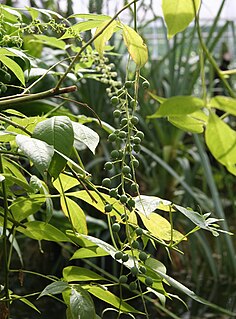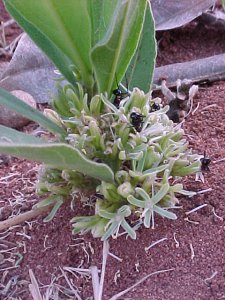
The Oxalidales is an order of flowering plants, included within the rosid subgroup of eudicots. Compound leaves are common in Oxalidales and the majority of the species in this order have five or six sepals and petals. The following families are typically placed here:

Circuit bending is the creative, chance-based customization of the circuits within electronic devices such as low-voltage, battery-powered guitar effects, children's toys and digital synthesizers to create new musical or visual instruments and sound generators.

The Potamogetonaceae, commonly referred to as the pondweed family, are an aquatic family of monocotyledonous flowering plants. The roughly 110 known species are divided over six genera. The largest genus in the family by far is Potamogeton, which contains about 100 species.

Virola is a genus of medium-sized trees native to the South American rainforest and closely related to other Myristicaceae, such as nutmeg. Species are known commonly as epená, patricá, or cumala. They have glossy, dark green leaves and clusters of tiny yellow flowers, and may emit a pungent odor.

Chrysobalanaceae is a family of flowering plants, consisting of trees and shrubs in 18 genera and about 533 species of pantropical distribution with a centre of diversity in the Amazon. Some of the species contain silica in their bodies for rigidity and so the mesophyll often has sclerenchymatous idioblasts. The widespread species Chrysobalanus icaco produces a plum-like fruit and the plant is commonly known as the coco plum.

Erythroxylaceae is a family of flowering trees and shrubs consisting of 4 genera and approximately 242 species. The four genera are Aneulophus Benth, Erythroxylum P. Br, Nectaropetalum Engl., and Pinacopodium. Erythroxylum novogranatense is also a coca plant.

Picrodendraceae is a family of flowering plants, consisting of 80 species in 24 genera. These are subtropical to tropical and found in New Guinea, Australia, New Caledonia, Madagascar, continental Africa, and tropical America. Its closest relatives are Phyllanthaceae.

Pittosporaceae is a family of flowering plants. The family includes approximately 200–240 species of trees, shrubs, and lianas in 9 genera. The species of Pittosporaceae range from tropical to temperate climates of the Afrotropic, Indomalaya, Oceania, and Australasia ecozones.
Sir Ghillean Tolmie Prance is a prominent British botanist and ecologist who has published extensively on the taxonomy of families such as Chrysobalanaceae and Lecythidaceae, but drew particular attention in documenting the pollination ecology of Victoria amazonica. Prance is a former Director of the Royal Botanic Gardens, Kew.

In traditional festive legend, Santa Claus's reindeer pull a sleigh through the night sky to help Santa Claus deliver gifts to children on Christmas Eve. The commonly cited names of the eight reindeer are Dasher, Dancer, Prancer, Vixen, Comet, Cupid, Donner and Blitzen. They are based on those used in the 1823 poem "A Visit from St. Nicholas" by Clement Clarke Moore, arguably the basis of the reindeers' popularity.

Prancer is a 1989 American-Canadian children's fantasy drama film directed by John Hancock, written by Greg Taylor, and starring Rebecca Harrell, Sam Elliott, Cloris Leachman, Abe Vigoda, Michael Constantine, Rutanya Alda, and Ariana Richards. It is set in Three Oaks, Michigan, where town exteriors were filmed. Filming also occurred at the Old Republic House in New Carlisle, Indiana, La Porte, Indiana, and at Starved Rock State Park in Utica, Illinois.

Barringtonia is a genus of flowering plants in the family Lecythidaceae first described as a genus with this name in 1775. It is native to Africa, southern Asia, Australia, and various islands of the Pacific and Indian Oceans. The genus name commemorates Daines Barrington.
Perebea is a genus of plant in family Moraceae.
Pseudolmedia is a flowering plant genus in the mulberry family (Moraceae). Species are found in southern Mexico, the Caribbean, and Meso- and South America. They are known in Latin America as lechechiva and used for timber, construction wood, and sometimes in folk medicine.
Tapura is a genus of plant in family Dichapetalaceae.

Tovaria is a genus of herbs native to Jamaica and South America. There are two species, Tovaria pendula and Tovaria diffusa. The genus is the only one in the family Tovariaceae.

I Love Money 2 or I Love Money is the second season of the VH1 reality television series I Love Money, created by Surreal Life executive producers Cris Abrego and Mark Cronin. The 19 contestants for the second season were drawn from I Love New York, Flavor of Love, Rock of Love, and Real Chance of Love to compete in physical and mental challenges, aiming for a $250,000 grand prize. Production began in late October 2008 & wrapped November 2008, and the show premiered on February 2, 2009 with Craig J. Jackson returning to host. The winner of the competition was Angela Pitts, also known as Myammee.














